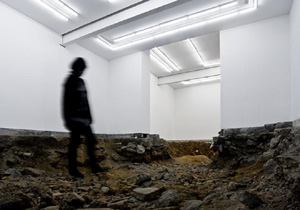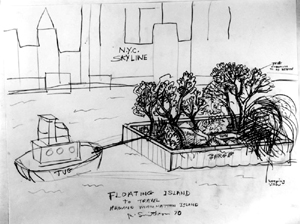Art After the Storm
John Haberin New York City
Hurricane Sandy Hits Chelsea
For four days, much of Manhattan alone was without power. A tropical storm had left us without water and our most basic means of communication—the Internet, phone service, mass transit, and, as it happens, art. By the weekend, power was starting to return. But art may not recover so surely.
At least one Lower East Side gallery canceled a Sunday opening the evening before the storm, fearing few would come. In the next days, as the Frick, the Drawing Center, and the Jewish Museum canceled their previews, it was more than a precaution. Still, by midweek Upper East Side museums began to open their doors.  Chelsea was another matter, a neighborhood that art had done so much to create and to define. I first read about it the old-fashioned way, in a print copy of The New York Times. Street-level galleries, it reported, held standing water, and basement storage was ruined.
Chelsea was another matter, a neighborhood that art had done so much to create and to define. I first read about it the old-fashioned way, in a print copy of The New York Times. Street-level galleries, it reported, held standing water, and basement storage was ruined.
That early report also said something about the importance of Chelsea to a broader culture, but what? Would the destruction distract attention from what really matters, meaning art, or would it call attention to the place of art in individual lives? Had Sandy destroyed all but the wealthiest, or had it leveled the flooded ground? Would it allow only the most elite galleries to recover? Or would their rapid response even beyond falling back on online exhibitions confirm that they, too, care deeply about art? Or I walked to Chelsea myself on the Saturday after the storm, as I would once again after the devasting gallery closures from Covid-19, unsure whether to be looking for damage or for art.
Out with the trash?
Looking for art beneath the High Line was simply foolish. Postmasters promised to welcome visitors at three with spiced wine—a reopening aided by a location east of Tenth Avenue, miniature American landscapes of post-digital refuse by Jennifer and Kevin McCoy that rest on tiny wall platforms or on tables safely above the floor, and years of dedication. It was, I believe, alone. Stores and restaurants, too, were shuttered, tape still crossing the windows of 192 Books. Elevators everywhere were dead. Alas, dozens and dozens of galleries would have envied their quiet.
Up on 26th, shielded by an extra block from the Hudson, one might be holding one's breath. Most there were cleaning up or attending to a belated hanging. At James Cohan, much of the art was already on the wall. Even a gallery below street level survived surprisingly well. They were the exceptions. Some were still assessing damage, as if sifting through sand in the art of Ann Veronica Janssens and Michel François, but for most sitting on one's hands was just not an option.
On Eleventh Avenue near 19th Street, water still pumped furiously into the gutter. From Cheim & Read or Marlborough on 25th all the way on down, two or three feet of drywall were ripped away. With Paula Cooper on 21st and her long commitment to her artists, one would expect nothing less. At Matthew Marks on 22nd, walls already awaited priming. At David Zwirner on 19th, things inside hung on lines to dry, while the gallery focused on reopening a single one of its spaces—for Diana Thater and, much like Jacob Kirkegaard, videos of another disaster area, Chernobyl. Signs elsewhere warned of a street closed to traffic for crane activity.
 They or the top tier along much of 24th Street have the money to deal with the problem. If some others, on safer blocks, could settle for fresh paint and taking out the trash, they were surely grateful. For those closest to the river, however, like CRG on 22nd Street, this was not just about clients with a certain need for perfection. The work was urgent. Sure, the show must go on, beyond belated Thursday openings, but when? Most Web sites were still silent—for galleries, this once, had more to worry about than publicity.
They or the top tier along much of 24th Street have the money to deal with the problem. If some others, on safer blocks, could settle for fresh paint and taking out the trash, they were surely grateful. For those closest to the river, however, like CRG on 22nd Street, this was not just about clients with a certain need for perfection. The work was urgent. Sure, the show must go on, beyond belated Thursday openings, but when? Most Web sites were still silent—for galleries, this once, had more to worry about than publicity.
I could have entered a neighborhood-wide construction site. For dealers and staff summoned on a weekend, there was no way around getting their hands dirty—especially on that vulnerable block an avenue further west, on 27th Street, where pedestrian traffic lights still lacked power. From Derek Eller and Wallspace through Foxy Production, common basement storage had taken an especial hit, and the landlord would be gutting it and replacing flooring, stirring up still more dust, for weeks to come. One could imagine the dumpsters in the street as shared as well. They were not, and Ed Winkleman and others were moving in and out of unlit interiors with hand-held receptacles of thoroughly wet trash. One could only hope that little or none of it was art.
Morals are easy to come by, as for Katharina Grosse faced with an abandoned building in Queens. One could see the pace of work as a sign of recovery or of disaster. One could see the ethos that makes dealers far more than entrepreneurs exploiting overpriced celebrity artists, or one could see the explosion of a neighborhood and an art scene beyond reason. The Museum of Modern Art offered advice on art restoration, but there was no escaping the extent of loss—or the complexity of art's changed place in culture and commerce, not just here but on the Lower East Side and in Brooklyn, where dreams of DIY or old-fashioned painting offer neither protection nor purity. "You'll be back," I said lamely to Winkleman, in sympathy and support. "Not this week or next."
Under water
The Times reporter was not an art critic, and his examples, to one who was, must have seemed arbitrary and naive. That had a lesson of its own, though. Contemporary art is now of broad interest, with small and big money in art alike at stake. Surely some readers, the editors knew, were already starved for it. Maybe some readers had a financial stake in the damage, too—and anyone looking to distinctions between, say, installations and the handmade for what can go wrong is looking in the wrong place. The reporter's choices held other lessons as well.
David Zwirner, in those days before a scheduled opening for Luc Tuymans, shows that no one is exempt, regardless of wealth or status. And that comes not as poetic justice but as a sense of shared loss. Zach Feuer, so soon after conceptual zingers from Mark Flood, shows that no amount of knowing mockery can shield art. The financial costs already create difficult balances. Chambers had moved from another location on a higher floor just this year, as a measure of success but also in search of street traffic. So indeed have Lombard-Freid just up the street and Nicole Klagsbrun a few blocks away, the latter at the price of a smaller space, not to mention quite likely a higher rent.
Otherwise, The Times went on with business as usual, until Roberta Smith on Saturday spoke sanely to the damage. Friday reviews covered a van Gogh portrait at the Frick and the reopening after a year of the Drawing Center, at that point perhaps for The Times alone. (There are press previews, and then there are press previews.) Other voices had a different urgency, especially bloggers. Linda Yablonski for Artforum was everything that The Times was not, with incisive details that truly lay out the risks and the loss. And where Yablonski was clear-headed, Jerry Saltz for New York brought his usual sympathy and passion. 
Between them, they found all my lessons and more. Both had a top reporter's and critic's access to dealers with much else on their minds than visitors, behind largely closed doors in a normally busy season. I am still haunted by the simple image of damage not to art at all, but to the staple of any gallery, drywall. They point to the financial complexities as well, including damaged works already promised or sold. Often as not, when insurance does not cover the full value of unsold work, the real hit is taken by the artist or (for work on consignment) a collector, to the point that one wonders why more dealers did not have the foresight to move things out of the basement. Maybe more crucially and contrary to popular belief, neither artist nor dealer deserves the loss—and often neither one can easily bear it, with so many surviving from month to month and day to day.
Top auction prices reflect a growing inequality, and that has to be bad for art, just as in the economy as a whole. Yet inequality is also about how little those prices alter the game for others in the end. The stereotype of Russian new money reflects something else as well, an unease with art's growing audience. After all those years of appropriation of pop culture, pop culture may be returning the favor, complicating Modernism's paradoxical idealism and exclusivity. That has perils, too, just like any shift in patronage, but it should not serve as an excuse for resentment. Dealers cannot solve everything by throwing money at it, which is why Larry Gagosian looks at his worst when he ventures beyond Anselm Kiefer or Pablo Picasso—and yet each of us has to face for ourselves the puzzle of what matters.
Less than a month before, David Hickey fed artist and popular distrust of markets and dealers by announcing that he could no longer write. After so much money focusing so much attention on the likes of Damien Hirst, he had nothing more to say. And yes, art is a business, and another lesson of Sandy is that there is no escaping it, by sincerity, purity, or art. In fact, Hirst's generation informed by critical theory had done plenty to point that out, with decidedly mixed results. And still the precise nature of art, self-interest, and commerce bears exploring rather than decrying, and still Hirst is long since past worth either one. After decades of conceptual art, art is still a physical object, bought and sold, created and cherished, exploited and abused, hated and loved—the kind that connects flooded minds to the world.

Tropical Storm Sandy hit coastal New Jersey around sunset on October 29, 2012, and New Yorkers lost power both from direct flooding in several boroughs and with an explosion at the Con Ed substation on East 14th Street in Manhattan at 8:30. The reports cited here began the next day, and my brief return to Chelsea came November 3. A few galleries held their expected evening openings on November 8 and 9, but many did not. A briefer, more up-to-date, and maybe more moving version of this appeared in Artillery magazine.




